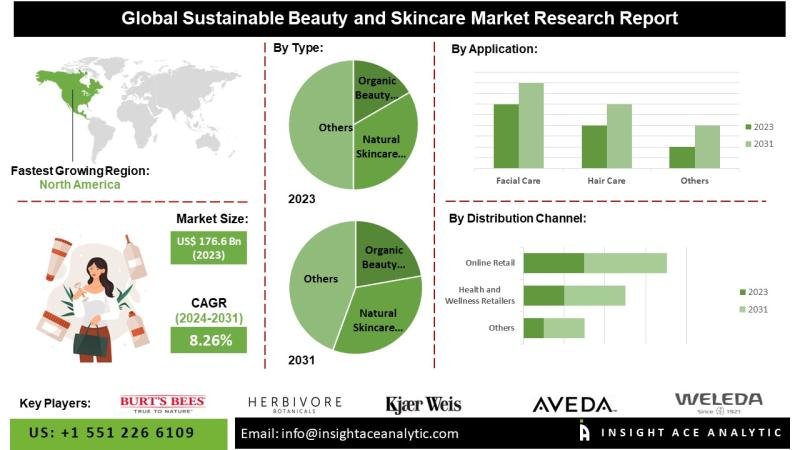The Growing Sustainable Beauty and Skincare Market: A Comprehensive Analysis
Image Source: Sustainable Beauty and Skincare Market
Introduction to the Sustainable Beauty and Skincare Market
The Sustainable Beauty and Skincare Market has garnered increasing attention, with projected growth from USD 190.7 Billion in 2024 to over USD 433.2 Billion by 2034, reflecting a robust CAGR of 8.6%. This report by InsightAce Analytic highlights key trends, drivers, and challenges in this evolving industry landscape.
Market Segmentation
1. By Type
- Organic Beauty Products
- Natural Skincare Products
- Vegan Beauty Products
- Cruelty-Free Cosmetics
- Clean Beauty Products
2. By Application
- Facial Care
- Hair Care
- Body Care
- Makeup and Cosmetics
- Fragrances
3. By Distribution Channel
- Online Retail
- Brick-and-Mortar Stores
- Specialty Beauty Stores
- Health and Wellness Retailers
- Direct Sales
4. By Region
- North America
- Europe
- Asia-Pacific
- Latin America
- Middle East & Africa
Key Market Drivers
- Rising Consumer Demand: The demand for cruelty-free, vegan, and ethically sourced products reflects a broader trend toward responsible consumption.
- Breakthrough Innovations: Advancements in green chemistry facilitate the formulation of eco-friendly products, reducing environmental impact.
- Sustainable Packaging Solutions: The beauty sector is witnessing significant innovation in sustainable packaging, including recyclable and biodegradable materials.
Innovations on the Horizon
- Nanotechnology applications are enhancing product efficacy and sustainable practices.
- These innovations are important for improving the bioavailability of active ingredients, paving the way for deeper skin penetration and controlled ingredient release.
“By prioritizing sustainability and transparency, we are reshaping how beauty products are formulated,” says an industry expert.
Challenges Facing the Market
- Formulation Issues: The use of natural ingredients can lead to challenges in product stability and shelf life, as they typically degrade faster than synthetic options.
- Consumer Awareness: Limited understanding of sustainable beauty products continues to hinder broader market adoption, calling for strategic marketing and education initiatives.
Regional Trends in Sustainable Beauty
North America
- The region leads the way in the sustainable beauty market, driven by a strong focus on ingredient transparency and ethical production. Innovations in sustainable chemistry and packaging are thriving here.
Asia-Pacific
- This region is experiencing rapid growth, fueled by an increase in disposable income and environmental awareness. The demand for eco-friendly products is anticipated to rise steadily.
Recent Developments in the Industry
- Ilia Beauty launched the Cleanse Soft Foaming Cleanser and the Bright Start Activated Eye Cream, both of which have seen impressive market traction.
- Burt’s Bees presented research at the Integrative Dermatology Symposium 2023, showcasing the benefits of their natural component formulations, including improvements for sensitive skin.
Prominent Players in the Market
A range of brands is leading the sustainable beauty movement, including:
- 100% Pure
- Acure Organics
- Aveda
- Burt’s Bees
- L’Oreal S.A.
- Unilever plc.
These companies are not only innovating but also setting standards for ethical sourcing and environmental responsibility.
Conclusion
The Sustainable Beauty and Skincare Market is poised for significant growth, driven by consumer demand for eco-friendly and ethically produced products. With technological advancements and an increasing focus on sustainability, the industry is not just responding to consumer needs but is also reshaping the beauty landscape for future generations.
For those interested in exploring further, read the comprehensive market report and stay informed about the latest trends and innovations in sustainable beauty.
By adhering to sustainable practices, the beauty industry is on the brink of a transformative shift that promises not only to meet consumer demands but also to significantly reduce its environmental footprint.


